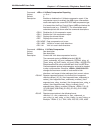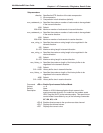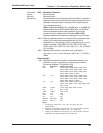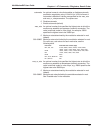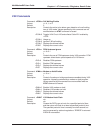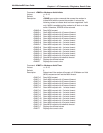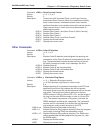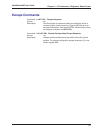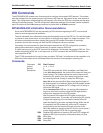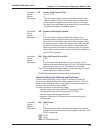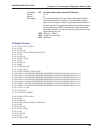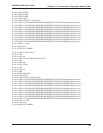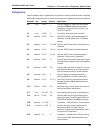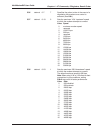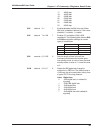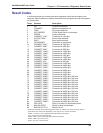
Chapter 4 - AT Commands, S-Registers, Result Codes
32
MultiModemDID User Guide
DID Commands
The MT5634ZBA-DID modem uses *D commands to configure the modem’s DID features. The modem
must be configured for the proper protocol, digit format, digit time out, digit report format, and number of
digits. This configuration is determined by the company from which the DID line is ordered and the setup
used by the phone company. The DID configuration parameter settings of the modem can be viewed as
part of the report of the AT&V command and can be stored with the AT&W0 command.
MT5634ZBA-DID Initialization Recommendations
Since the MT5634ZBA-DID can be processing a DID call before signaling the DTE, care must be
taken to avoid unexpected call problems.
The first command of an initialization string should probably busy out the DID line. This will allow calls
to rollover to other trunk lines in a trunk system or receive a busy signal in a single-line system. This
will also avoid problems such as missing the incoming DID number information or causing a
character abort of the incoming call after the DID information has been received.
Conversely, the last command to give the modem should be the AT*DS configuration command
putting the modem back in service and ready to receive incoming DID calls.
A check has been put in the AT&F command to determine if the modem has started a DID call. If the
modem has started a DID call, it will respond to an AT&F command with an ERROR response and
not process the AT&F.
The AT*DW command can be used to keep a modem “Off Hook” or busied out at the completion of a
DID call so the modem can be initialized without the concern of corrupting an incoming call.
Commands:
Command: *DS Start Protocol
Values:
n
= 0, 1, 2 or 3
Default: 0
Description: Three DID start protocols: Wink, Immediate, and Delay Dial:
In the Wink Start protocol, the central office closes the loop and
draws current. The modem senses the current draw and will
reverse the DC polarity for a short pulse to signal that it sees
the incoming call and is ready to accept the DID digits.
Delay Dial is the same as Wink Start except that the length of
the reverse pulse is not defined. When the DID modem senses
the current draw, it reverses the DC voltage until it is ready to
receive the DID digits.
On an Immediate Start DID line, the central office closes the
loop for a short time and then sends the DID digits without
waiting for a response from the DID modem.
After the central office sends the DID digits all three lines
operate the same way. The modem will reverse the DC polarity
to signal the beginning of the call and the central office will
open the channel to the caller and begin billing. When the call
is completed, the DID modem will return the DC voltage to
normal polarity and the central office will open the circuit.
While the modem is monitoring the DID line for current draw, it
is also monitoring the POTS line for incoming rings.
*DS0 Disables DID detection of incoming DID calls (DC voltage still
applies to DID line, but polarity is reversed to busy out line).
*DS1 Wink Start
*DS2 Immediate Start
*DS3 Delay Dial



